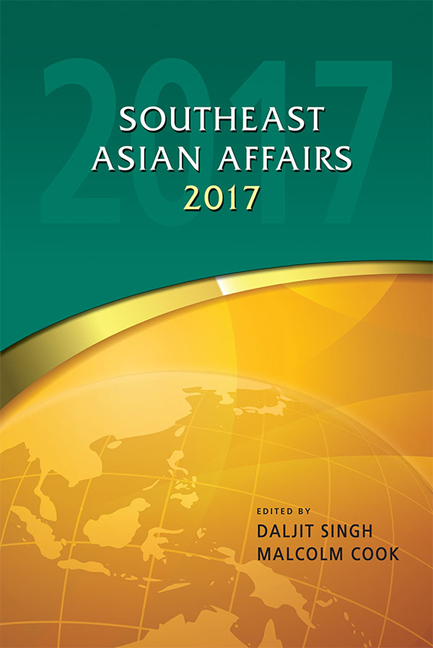Book contents
- Frontmatter
- Contents
- Foreword
- Introduction
- Acknowledgements
- THE REGION
- Southeast Asia in an Age of Strategic Uncertainty: Legal Rulings, Domestic Impulses, and the Ongoing Pursuit of Autonomy
- Southeast Asian Economies: In Search of Sustaining Growth
- Forging the ASEAN Economic Community, 2015 to 2016 — and Beyond
- Southeast Asia's Demographic Situation, Regional Variations, and National Challenges
- U.S.–Japan–Australia Strategic Cooperation in the Trump Era: Moving from Aspiration to Action
- Blurring the Distinction between Huaqiao and Huaren: China's Changing Policy towards the Chinese Overseas
- BRUNEI DARRUSALAM
- CAMBODIA
- INDONESIA
- LAOS
- MALAYSIA
- MYANMAR
- THE PHILIPPINES
- SINGAPORE
- THAILAND
- TIMOR-LESTE
- VIETNAM
Forging the ASEAN Economic Community, 2015 to 2016 — and Beyond
from THE REGION
Published online by Cambridge University Press: 12 January 2018
- Frontmatter
- Contents
- Foreword
- Introduction
- Acknowledgements
- THE REGION
- Southeast Asia in an Age of Strategic Uncertainty: Legal Rulings, Domestic Impulses, and the Ongoing Pursuit of Autonomy
- Southeast Asian Economies: In Search of Sustaining Growth
- Forging the ASEAN Economic Community, 2015 to 2016 — and Beyond
- Southeast Asia's Demographic Situation, Regional Variations, and National Challenges
- U.S.–Japan–Australia Strategic Cooperation in the Trump Era: Moving from Aspiration to Action
- Blurring the Distinction between Huaqiao and Huaren: China's Changing Policy towards the Chinese Overseas
- BRUNEI DARRUSALAM
- CAMBODIA
- INDONESIA
- LAOS
- MALAYSIA
- MYANMAR
- THE PHILIPPINES
- SINGAPORE
- THAILAND
- TIMOR-LESTE
- VIETNAM
Summary
At the end of 2015, ASEAN did not any more become a community of nations than remain an association of states. Words matter for the expectations they raise. ASEAN slow marched in 2015 towards the “milestone” that it was to be proclaimed a “community” at the end of it, but in reality this remains an admitted work in progress.
The term “community” had been adopted in communion with, although not as a replication of, what existed in Europe. It seemed like a good idea, this approximation, which got more distant as Europe further integrated into a union of twenty-eight nation-states. Of course, nowadays, ASEAN may congratulate itself on its superior wisdom of not rushing into forming a community, let alone a union, seeing the strains and stresses in the European Union (EU). But the term “community” remained.
For the private sector there are clear expectations of the ASEAN Economic Community (AEC), perhaps even more so than from constituents of the politicalsecurity and sociocultural pillars, the two other legs of the community proclaimed in the Kuala Lumpur Declaration of November 2015. It is in the AEC that the ASEAN Community shows the greatest promise of development. Indeed, it may very well be the AEC that will hold ASEAN together, even if it does not necessarily drive greater integration with the other two pillars. There are however challenges ahead, both internal and external to the AEC, including from geopolitical and geoeconomic forces beyond ASEAN's loose organizational control.
What is the AEC to the Private Sector?
When an integrated regional market, open to the outside world, is offered with a single production base complete with the free movement of goods and services, capital and investment, and skilled labour, it is a huge attraction. If the market proposed is the third largest in the world, with a population of over 630 million people, a combined GDP in excess of US$2.4 trillion — the world's seventh largest — growing at about five per cent in an anaemic world economy, businesses are attracted to make decisions and plans for their future expansion there. And, with sixty per cent of the population under thirty-five years of age, there is the further enticement of current investment yielding a demographic dividend not better available elsewhere.
- Type
- Chapter
- Information
- Southeast Asian Affairs 2017 , pp. 43 - 54Publisher: ISEAS–Yusof Ishak InstitutePrint publication year: 2017

